Best electric cargo bikes and how to find your perfect one
How to become a car free and embrace daily life on a bicycle made for two, three, four and more
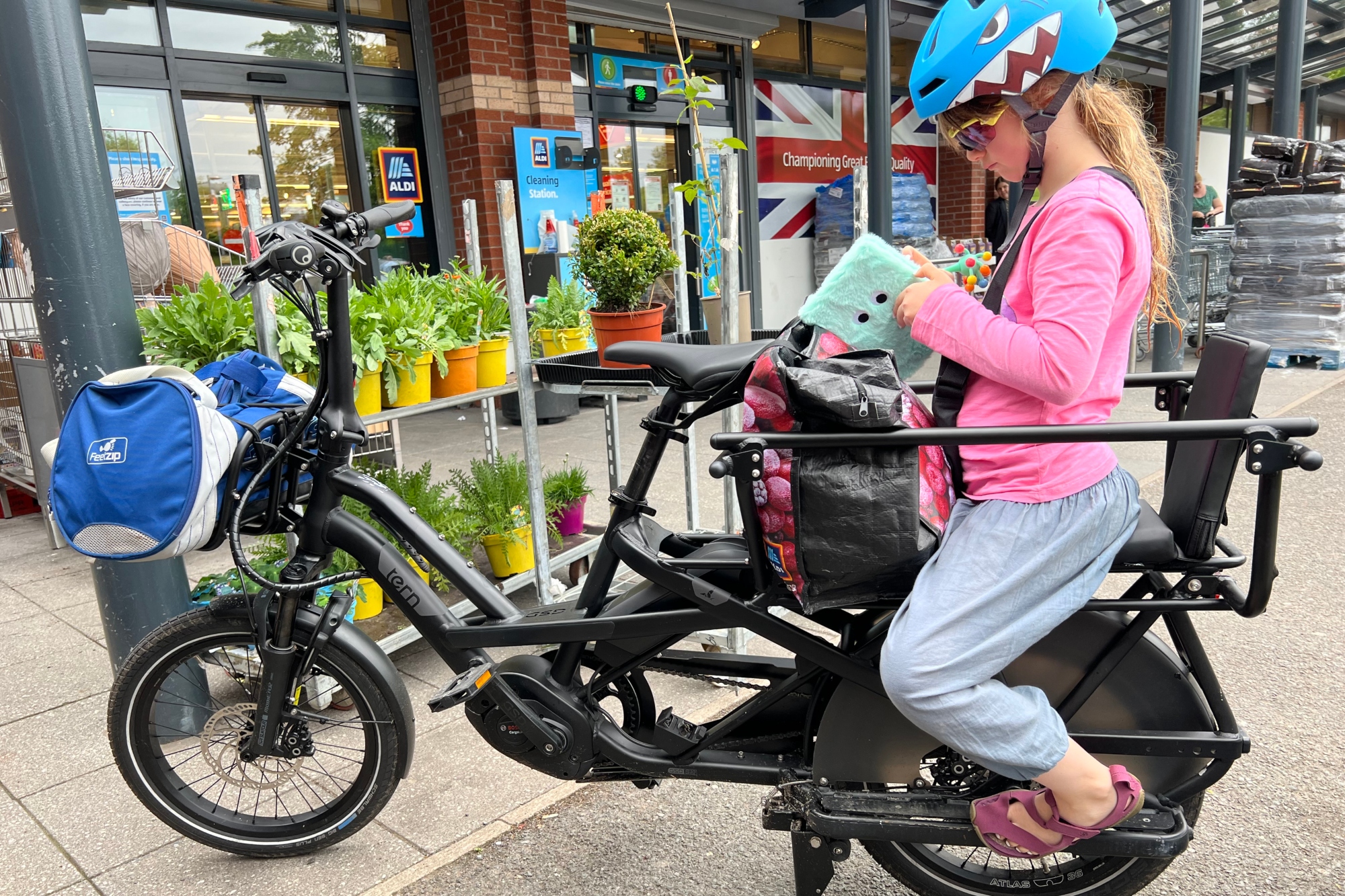
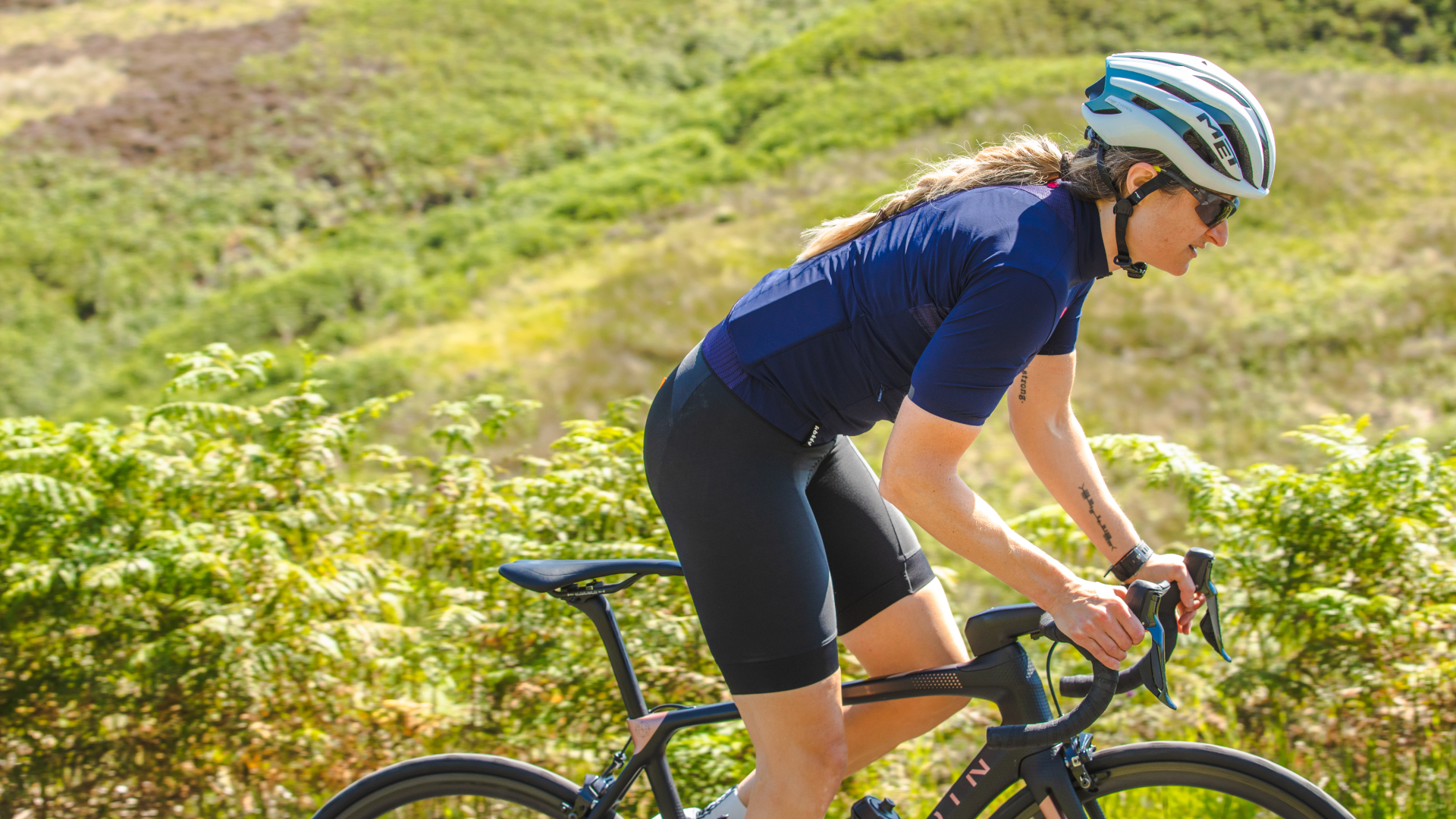
From faster commutes to drastically cutting emissions from fossil fuel vehicles, there is a multitude of benefits to owning one of the best electric cargo bikes.
With the capability of carrying two children and shopping, the latest e-cargo bikes offer a realistic alternative to the car, even when you don’t live in the flat lands of Holland.
For that reason, all our cargo bikes are electric cargo bikes, as we test in far from flat terrain. If you're already a fan of the best electric bikes, you'll know the benefits that a little extra power can bring on a ride, and with a heavy load, it's more of an essential feature.
We've tested the best electric cargo bikes on the market right now, putting them through their paces as a direct car swap for a busy working family, in rather hilly terrain and in a mix of rural and urban environments.
Underneath our bike recommendations, we have all your cargo bike questions answered, and include tips on how to find the best electric cargo bike for you and your family.
It's worth noting here that our e-cargo bikes are as defined by the laws in the UK and USA. Our page on how to buy an e-bike tells you everything you need to know about electric bikes before you make your purchase, and our best e-bike insurance answers questions about the law of insurance for an electric bike.

A long standing staffer at Cycling Weekly, Hannah has raced and ridden bikes across the globe. She still does, just now with her daughter alongside, too. As the CW team's resident expert on cargo bikes – riding them on- and off-road, up hill and down dale (now a minor celeb in the village as a result) – if she's not on a cargo bike, she'll be talking or writing about them.
Best electric cargo bikes
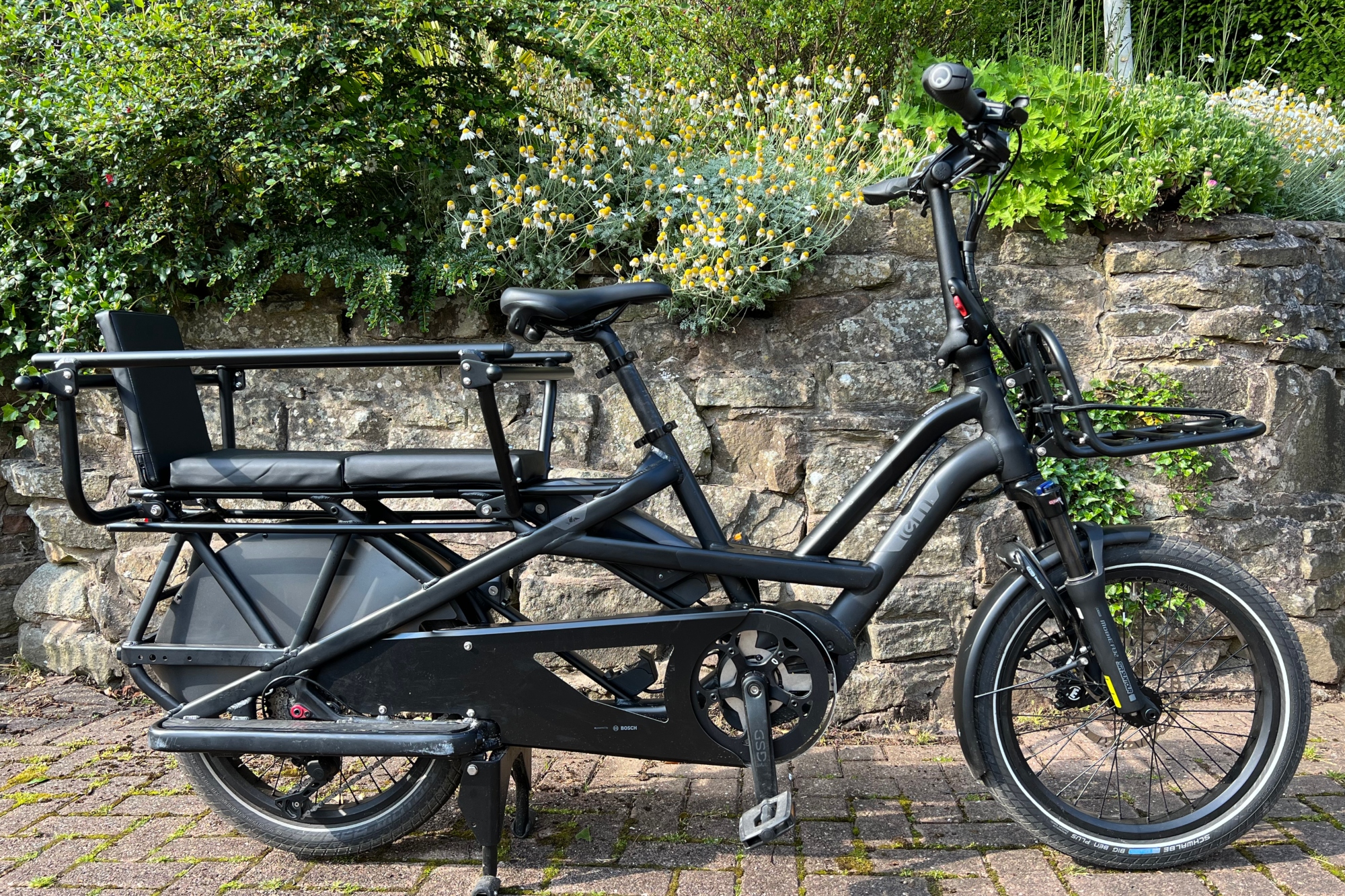
The Tern GSD S10 electric cargo bike
Specifications
Reasons to buy
Reasons to avoid
To say I loved the Tern GSD S10 is an understatement. It's by far the easiest electric cargo bike I've tested in terms of direct car swaps, using for ferrying round child and accompany paraphernalia, shopping and even both at the same time as there's so much versatility and cargo load options.
I've been riding the S10 edition, which come with a 400wh battery, but there is an LX which has a little more battery oompf at 500wh over the regular Tern GDS S10, although both come equip with the Bosch Cargo system.
This motor and battery combo is noticeably superior to others, the non-branded 250w of the Mycle Cargo for example, with the power assist instant (both on and off), without overpowering ride feedback, making it as close to a natural ride feeling as possible, which in turn makes you feel more in control and confident when riding.
My riding naturally demands a lot of power due to the topography where I live, so I tend to get through about a third of one battery over around eight miles of use. I'd certainly not get the full 60 or so miles from one battery, but so far, as expected it's a similar range with the Raleigh Stride 2 (as it has the same set up), but a lot further than the Mycle Cargo bike, where I tend to knock out half of the suggested battery for the same duration.
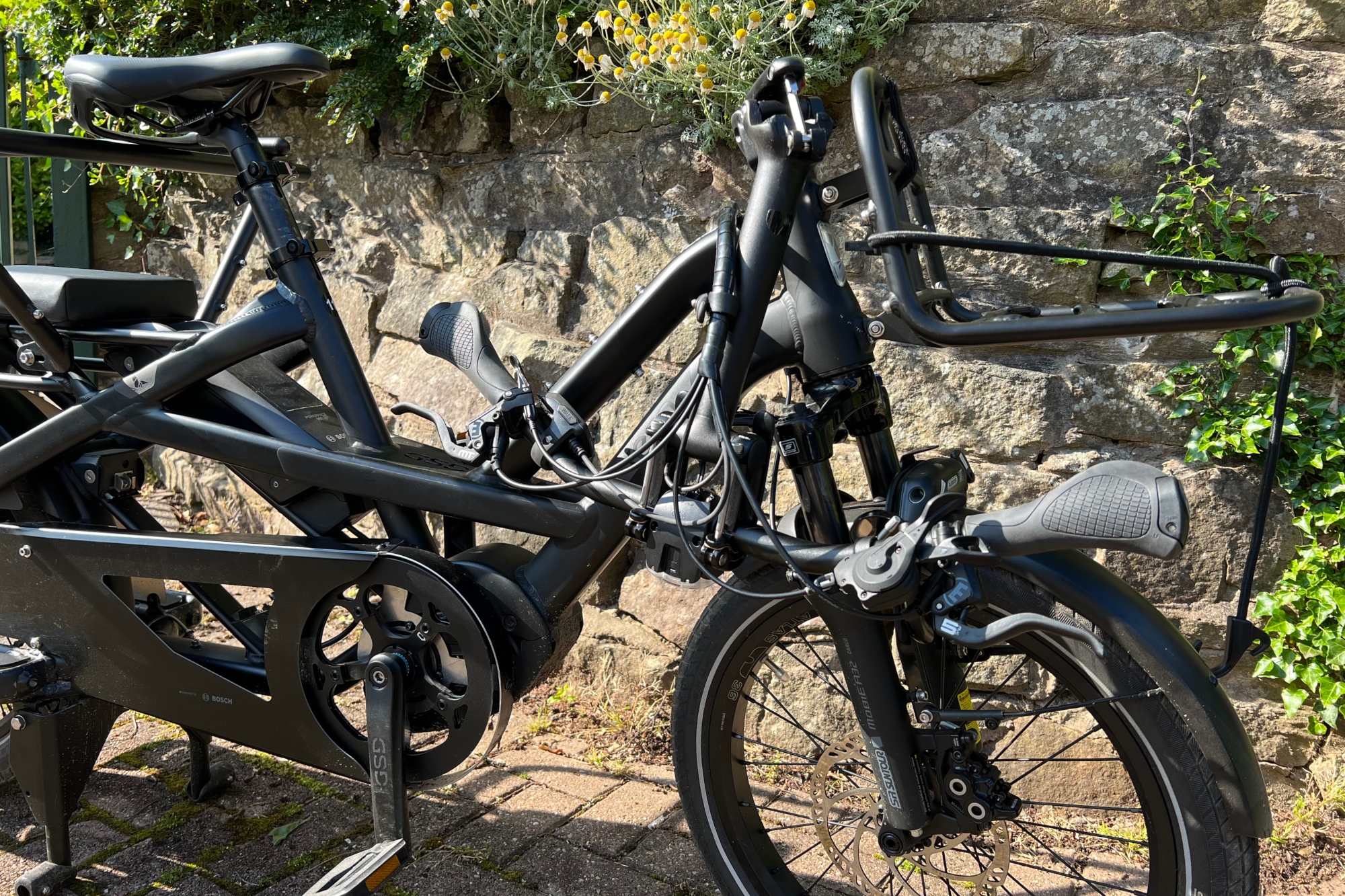
The Tern range of electric cargo bikes can be folded flat for space saving or transportation.
It's worth reading the 'how we test' section below to get a better idea of the riding the Cargo bikes have been put through and how battery assessments have been made.
The Magura MT5 eSTOP hydraulic disc brakes worked like a dream, and even on the steep descents of torrential rainy rides, didn't even require an excessive stopping distance extension. The Always-on RearStop™ Brake Light which signals stops is a really nice safety feature, with the bright front light making me feel more visible to other road uses. Both being integrated is incredibly helpful too.
In an ideal world, the other integration would be a clock display and even a basic sat-nav, which with cargo bike friendly mapping, would totally level up the going by bike life change. Which, at over £5,000 for the Tern GSD S10, you have to be wholly committed too, so throwing a GPS unit in with the price doesn't feel too unreasonable to ask.
It's this price tag that has also meant a lot of uneasiness about locking the bike up and leaving it unattended. The integrated Abus Wheel Lock and keyed-alike with the battery is some comfort, but even in areas that I know we won't be long, I've always double secured it with one of the best bike locks that is alarmed too.
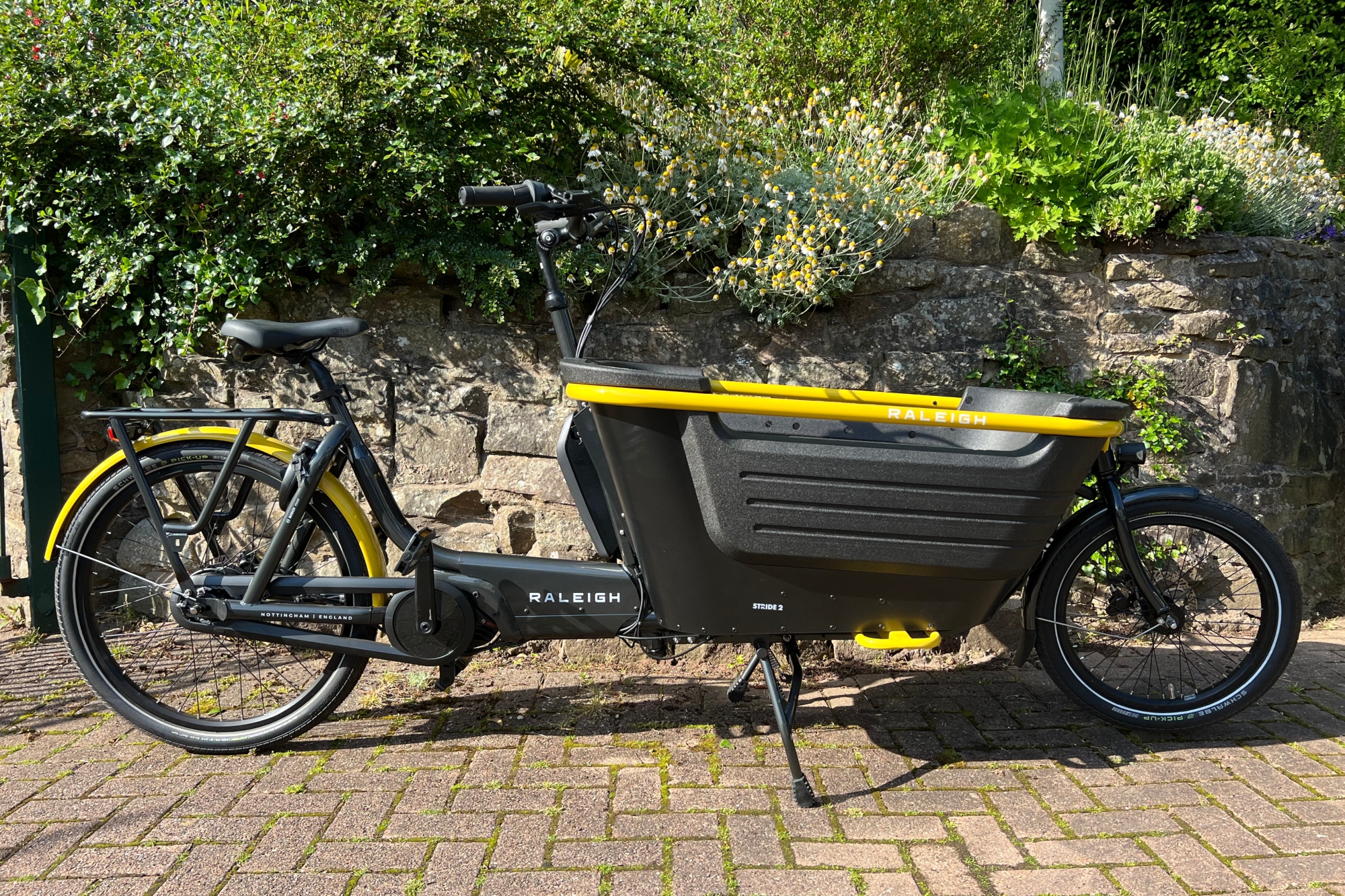
The Raleigh Stride 2 electric cargo bike
Specifications
Reasons to buy
Reasons to avoid
The Raleigh Stride 2 has all the constituent parts that make it an A-typical box cargo bike, with the out front loading tub that we've been accustomed to seeing in places like the Netherlands. Ditching the car getting the whole family (well adult and up to two or three little ones) on the bike has never looked so easy.
There's no denying that the Raleigh Stride 2 is one of the best cargo bike performers as there is a lot to love. The obvious is the ability to really opt out of car ownership while still hauling a family round thanks to its compatibility with Maxi Cosi Car Seats, although it's up to the individual to decide when is a good age to carry them, with most suggesting three months upwards).
This still leaves room for another child and the load that comes with a family on any journey and, importantly, be able to keep an eye on them.
Even if you aren't looking to load up on small kids, it's a great versatile space for shoving any load in and not having to worry how secure it all is, unlike the Tern GSD S10 where everything is behind you and there is an urge to check it's all intact.
While this is great for my disorganised life, the bucket design for cargo does mean that you loose all your front wheel visual feedback, making it really hard to get to grips with unless you are a really confident rider to begin with.
You also need to be a pretty tall one, as at 5ft6" (170cm) to ride, I was hardly able to touch the floor if on the saddle, even with the saddle fully down.
That said, once you are rolling, it does an excellent job with the same Bosch Cargo system that the Tern GDS S10 uses providing all you need in terms of additional instant pedal power. It's also uses a similar Magura CT hydraulic disc brake set up, which again provides confidence in your overall control of the bike, once you've got your head around steering it.
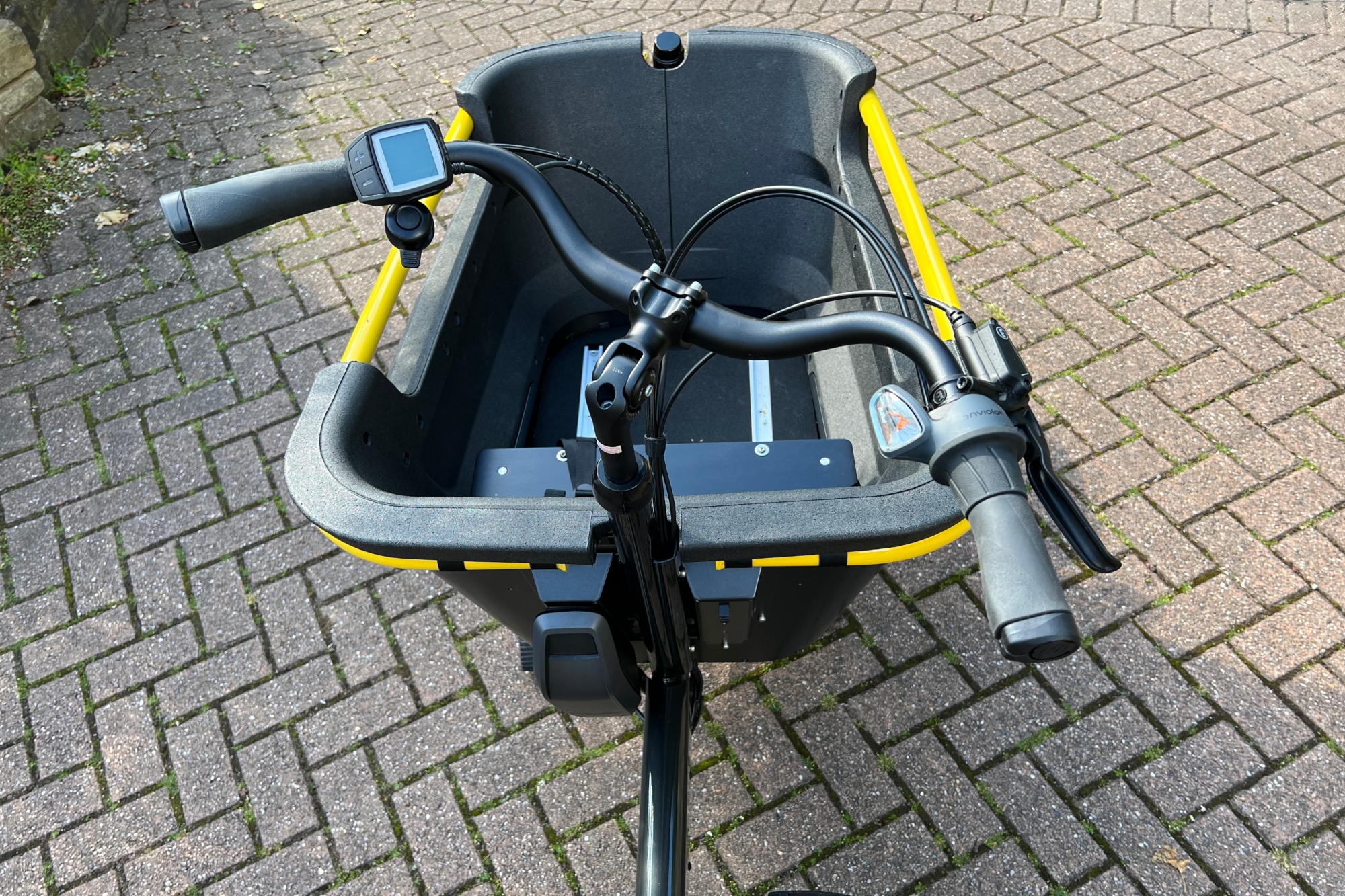
The Enviolo NuVinci gear shift easy to use, the not being able to get visual feedback when turning makes it less easy to steer.
The stand out feature is the Enviolo NuVinci gear shifting system. It's the same as the Canyon Precede:ON CF 9 ST uses, and is ideal for electric cargo bikes. Allowing you to have a step-less gear change for smooth riding is great, but being able to change gear to get the bike going up hill from a dead stop, which is a lot round here, is brilliant, as is doing away with any 'step-change' that you would find on a regular hub, and the maintenance of a regular derailleur gear shift. .
This feature comes into its own when you are first at the lights with the traffic building up behind you, as unlike the Tern GDS S10 or Mycle Cargo, the wide bucket means you don't gain the same traffic weaving riding perk, and you're even limited as to where you can – and, unfortunately, often can't – ride such a wide load, requiring you to stick in the traffic on the roads.
Sticking with hills, as I mention in the 'how we test section' and above, I live in a really hilly location, and as with the Tern GSD S10 I have to spend a disproportionate amount of time in power hungry 'Turbo' setting to get around. This eats battery charge quickly, about a third of one battery over around eight miles of use. I'd certainly not get the 40miles suggested on the Raleigh Stride 2.
It's in the region of £1000 cheaper than the Tern GSD S10 at £4,400, which is still a big commitment, but cheaper than car that's for sure.
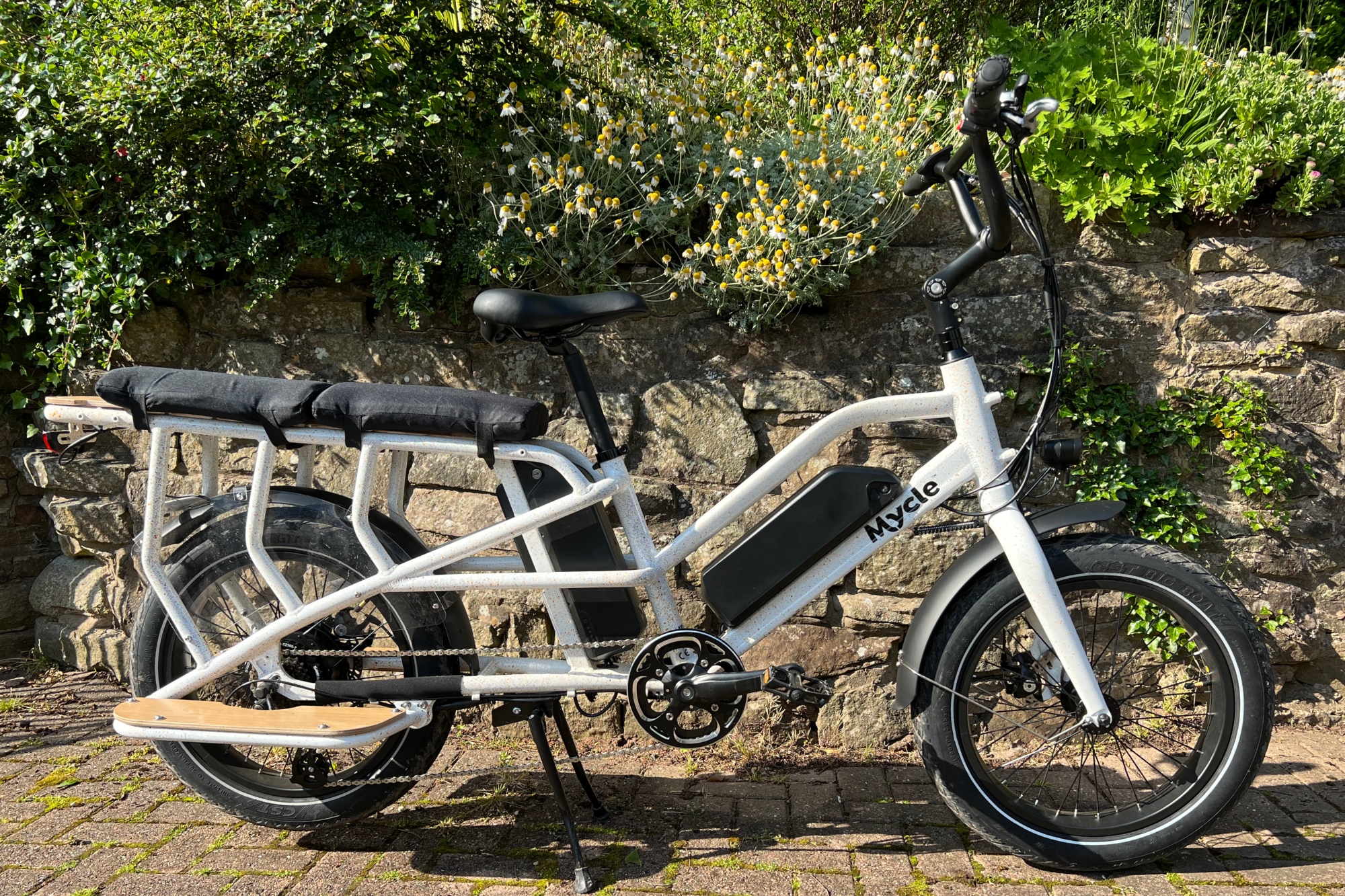
Mycle Cargo Electric Bike
Specifications
Reasons to buy
Reasons to avoid
At less than £2000 the cost of the Mycle Cargo Electric bike is a big draw, especially when up against the, more than double the price, Tern GSD S10 and Raleigh Stride 2 electric cargo bikes.
The Mycle Cargo Electric is really easy to get going on straight out the box, as it's longtail design, like the Tern GSD will be second nature to anyone who has bike riding experience.
I loved the ability to ride like a regular bike, taking advantage of the bike and canal tow paths as the bike was slim enough to get through the pinch points, which unfortunately stopped the Raleigh Stride 2 in its tracks.
I mostly loaded up with my eight year old and our rucksacks, but there is the option of attaching a couple of bike seats for younger ones, or swopping the seat out for a basket. Unfortunately, this doesn't leave enough room for a passenger, so it's an either / or in terms of load carrying. I also really missed the cage of the Tern GSD S10 LX, especially after my fearless 8 year told me it was cool to ride without holding on to anything.
The most obvious difference between the Mycle, Tern and Raleigh is the battery and motor. The unbranded Mycle is nowhere near as refined as the Bosch Cargo range, and the time lag on power assisted pedalling is really noticeable, with a lot of over run when backing off the pedals, or delay in coming in to action.
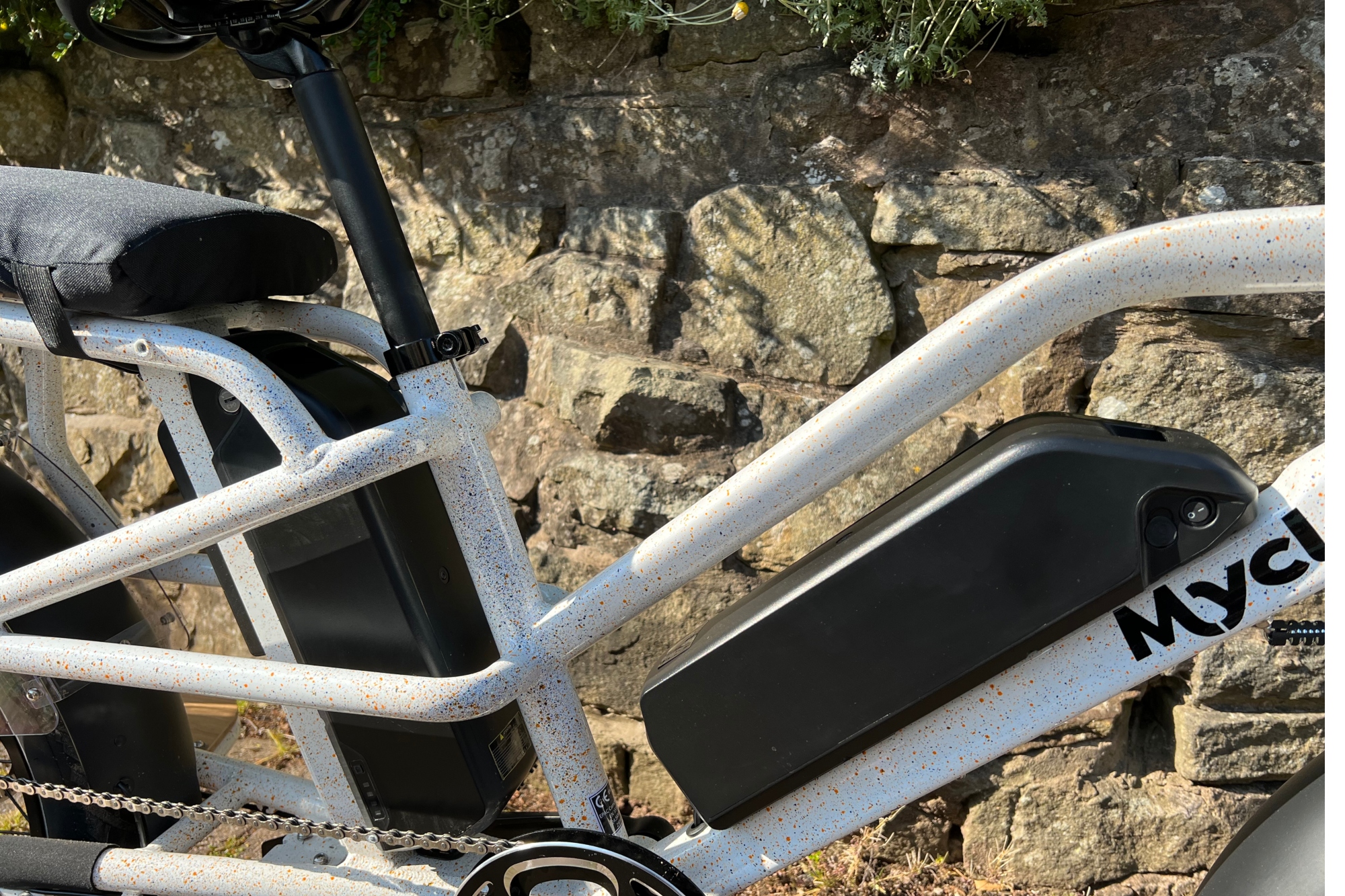
The Mycle Cargo Electric bike has twin batteries mounted from the off.
There are two batteries on the Mycle, which should, according to the brand give a 120mile range. This wasn't my experience, but as I've explained above and in the 'how we test' section below, I do live in an incredibly hilly area. After around 15 to 20 miles, I'd be down by about half or two thirds, going off the digital battery display.
It's worth noting that with an additional adult on board as the cargo, and covering some very hilly miles, the battery did seem to hold power at a similar rate as the Tern GSD S10 LX, which was ridden at the exact same time, with the 8yr old cargo. The Mycle Cargo Electric Bike also had much more power than the Tern, easily pulling away up hill with significantly less effort from the rider, it could just really do without the time-lag in terms of power kicking in, would would make it a brilliant option.
It's also worth noting that there's also no speedo, so I wasn't at all aware of what speeds I was doing. It's not a deal breaker, and unlikely that you'll break any highway laws, but it was missed.
It's always going to be hard to live up to wealthier peers, and for the price, Mycle puts up a good fight. It's not perfect, but the lower, and more accessible, price point with some really great features that make it very useable, will hopefully get a lot of people out of cars and on to bikes, which is surely the ultimate measure of success and only one that really matters.
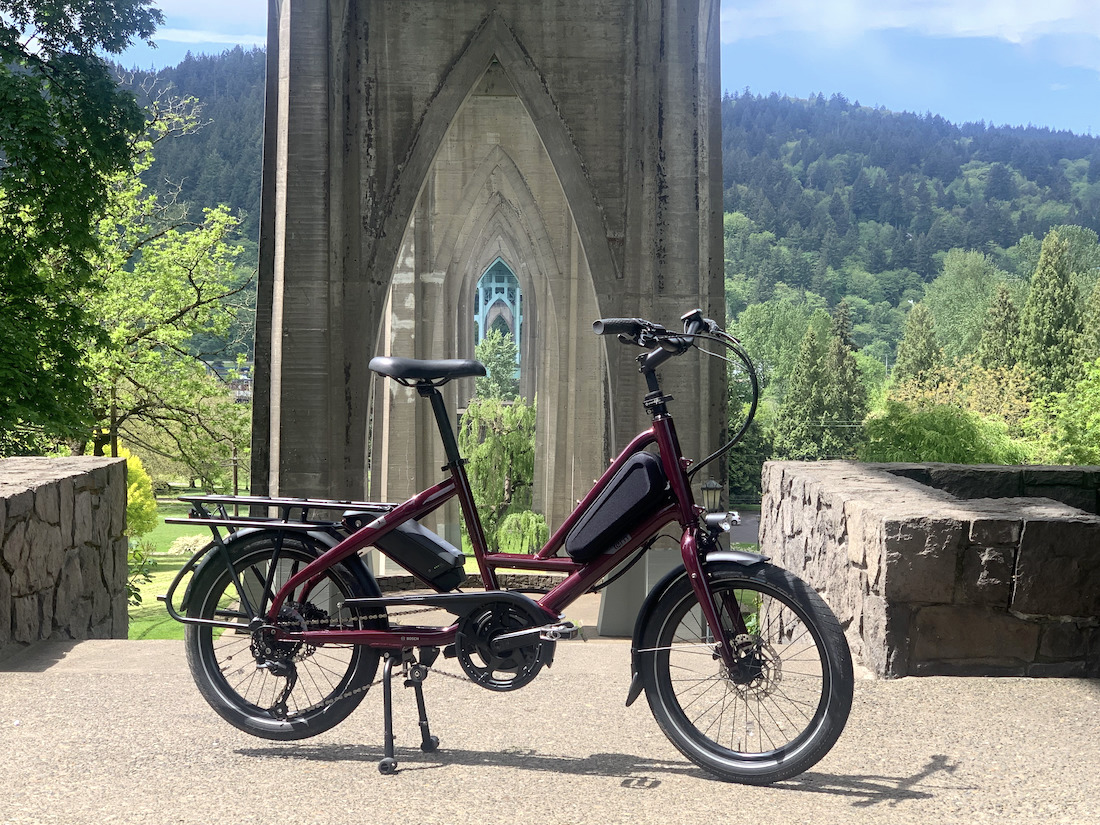
Specifications
Reasons to buy
Reasons to avoid
The Quick Haul D8 is small but almost perfectly formed. It's built around a compact one-size-fits-all frame that's designed to be a daily all-rounder.
Equipped with a Bosch motor and battery, it provides up to 50Nm of torque, 270% of support and claimed range of up to 65 miles. It uses a Shimano 1x8 drive chain, paired with hydraulic disc brakes - helpful when carrying the maximum load of 150kg (which includes the rider).
It's fitted with integrated lights and also comes with fenders, a chain guard, a bell and a kickstand.
Cargo is carried via the rear rack, with a 50kg maximum load. There is the option of a front rack too, but this is an after-market purchase. In fact, a lot of the carrying accessories required to make the Quick Haul D8 truly functional are 'add ons', and would have to be figured into the overall cost. That said, the bike itself is offered at a competitive price point.
On review we found the Quick Haul D8 to be a nimble ride, with the compact frame and 20" wheels making it handle well even when carrying cargo. The motor was quick to engage and was both smooth and quiet. And while it isn't the most powerful it generally works as you'd wish, though naturally for a Class 1 motor, isn't going to fly up steep hills.
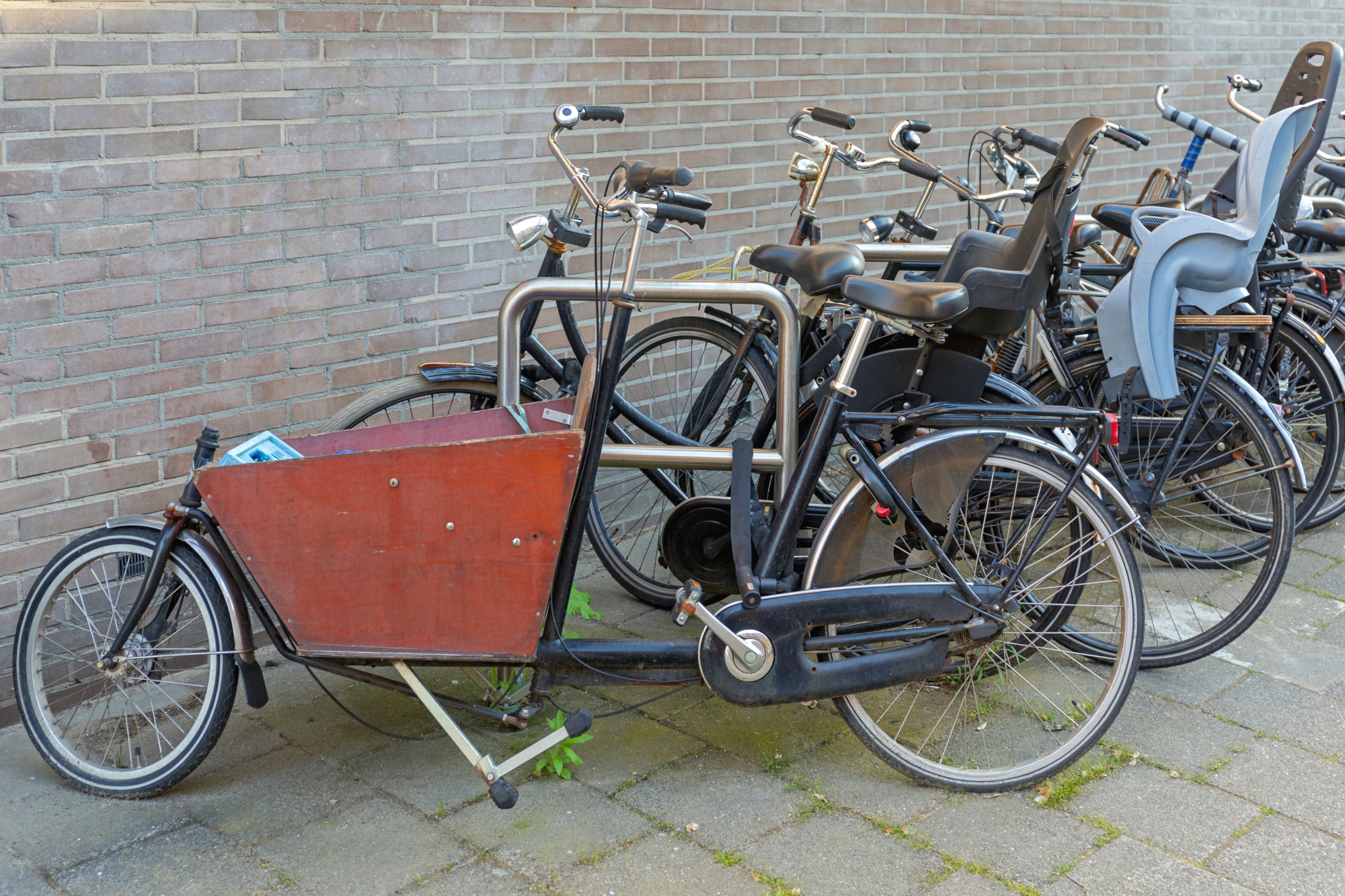
There two types of cargo bikes either front or rear load dominant.
How we test: Cargo bikes
All of the cargo bikes in this buyers guide have been put through their paces by the same family, with some input from friends along the way where we've become so converted we've suggested others try too.
We've tried to choose direct cargo bike for car swaps wherever possible. We have a slightly un-conventional life, so it's rear that two days are the same, but in the main journeys were a maximum of 20miles in-between charge.
It's worth noting that where I live is exceptionally hilly, its lowest point is 300ft above sea level, rising to 1000ft. Even the canal has 16 locks and aqueducts to contend with the extreme varying terrain. This means on tests, even the best electric cargo bikes have a big demand on the battery and motors.
I can only estimate battery life based on the visual power display screens that the cargo bikes come with. I might be way out, but as there is no way I could ride any of the cargo bikes I've tested without a motor, I'm not willing to gamble and run out of battery away from home as none of the cargo bikes on test can be rescued by car.
Types of Cargo bikes
There are two main designs of cargo bikes, with either front or rear dominant load carry.
Front load dominant bikes are often referred to as box bikes, or Long Johns, can be two or three wheeled and often have a bucket load or flat platform for either people or luggage/ cargo of your choice.
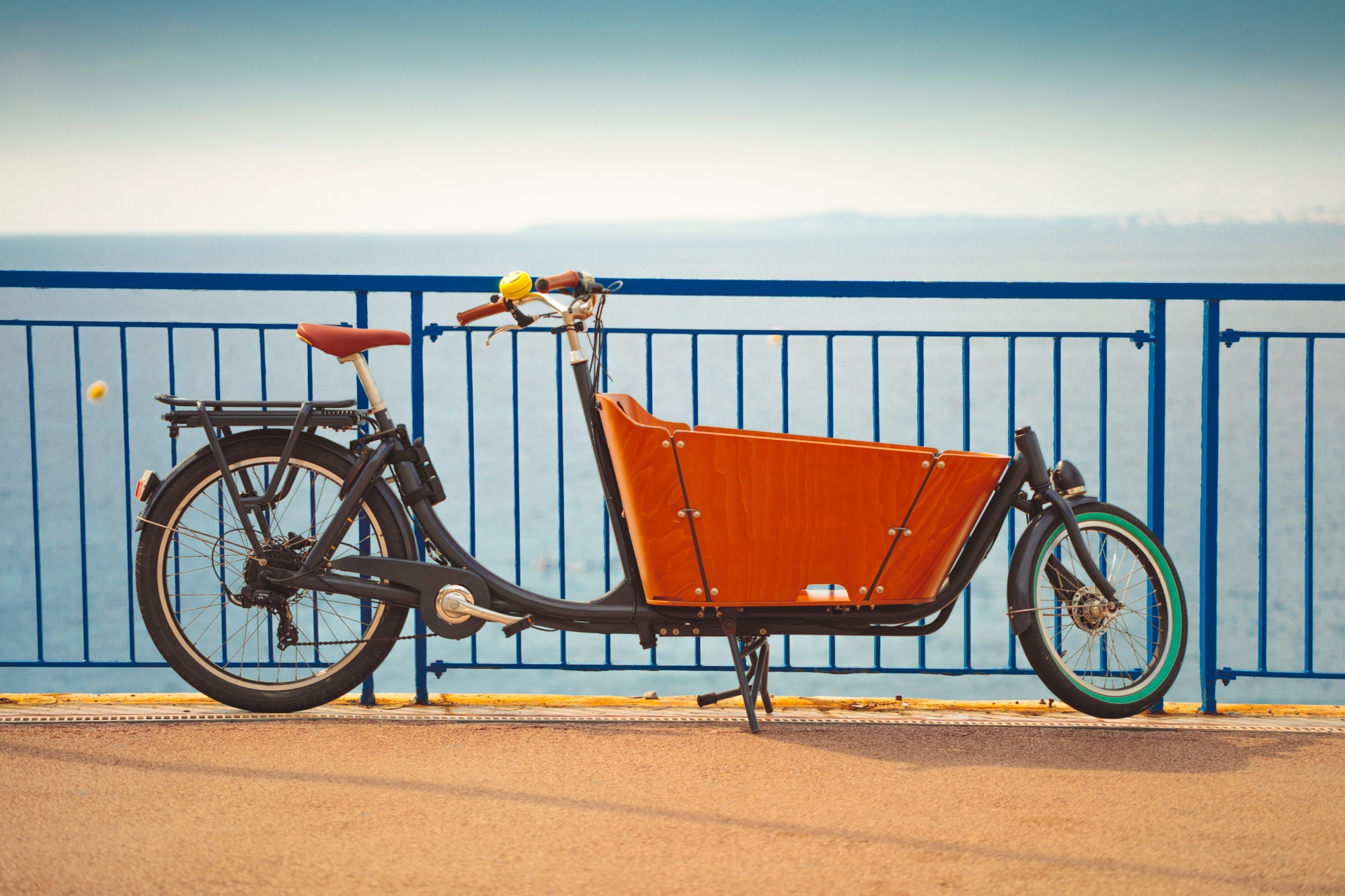
Box bikes are great for carrying younger children and lots of shopping.
With a box bike, the cargo box is positioned between the rider and front axle using a long slug frame, with a steering linkage that runs from handlebar to fork. This design tends to have the biggest cargo carry capacity in terms of volume, as the ‘carry’ is often a bucket or trough design.
The pros of this design are that if you are porting children around, they are in your line of sight, and shopping can easily be loaded up.
The cons are that this design is not as configurable, so although you can get lots of accessories, you’re fundamentally stuck with the bucket /box design.

Rear cargo bikes tend to be a longtail design, which means the main cargo load will be behind you. This is effectively a longer rack, which you can then attach child seats, framework or baskets.
The pros of a longtail are that other than a long wheel base (the distance between the two wheels at the point of which they touch the ground) longtail bikes are not that dissimilar to regular bikes in terms of rideability and width. They’re also highly configurable, so you can easily swap out chairs for baskets or boxes on a ride by ride bases.
The cons of this design are that you can’t see what your passenger is up too, which means you have to be pretty trusting that they’re not going to try and rear steer the bike with their weight and you can’t see your load is still intact after hitting the speed bumps.
Whatever design you settle on, it’s worth noting that they can be pretty bespoke in terms of actual build. The best electric cargo bikes will have lots of optional extra accessories, from the aforementioned child seats, or adapted for wheelchair users, and corresponding rain covers, baskets for loading shopping, or even refrigerated boxes for commercial uses.
Are cargo bikes hard to ride?
Can anyone ride a cargo bike?
Everyone can learn to ride a cargo bike, but it might take some practice depends on the rider, their experience and the model of the cargo bike.
The biggest differences between an electric cargo bike and a regular bike is the length, weight distribution and, if you haven’t ridden an electric bike before, riding with a motor.
I found that the longtail designs, where the heaviest cargo load is out back, felt most like riding a regular bike. The ride feel is intuitive, and even with a longer wheelbase, if you’ve ridden with panniers before, you’ll quickly adapt to riding with an additional person/ shopping on board. They are similar in design to a tandem bike, but personally I found them a lot easier to manoeuvre with the weight just that little lower than the riders saddle.
The two wheeled box bikes can be harder to ride as the weight load is further forward than you will be used to. While this doesn’t impact the weight of the steering, the biggest challenge is that there is a lot more bike length ahead of you, and it’s unlikely that you will have sight of your front wheel. This combination, whereby the bike will turn, but the load still looks like it’s facing forward for me, created an optical illusion that made it harder to ride the bike, resulting in several ‘training rides’ before becoming comfortable and confident enough to ride on the public highway.
Having a motor onboard is a must have with any cargo bike, with the bikes themselves weighing between 60 to 70 kilos / 132 to 154 pounds and around an additional 100to 150 kilos/ 220 to 300 pounds as cargo, and then your weight as a rider (there’s generally a max rider weight of around 100kg/ 220lbs), anything other than pan flat or downhill is impossible without my un-ceremonially dismounting cargo (often a cross child).
On the best electric cargo bikes, the motor will have setting options to add enough power to make your ride comfortable and hills surmountable. The power should be instantly active on pedal pressure, apply predictable assistance allowing you to be in complete control of speed and stopping.
How fast can a cargo bike go?
Do electric cargo bike's have speed limits?
Like all electric bikes, the top speed of even the best electric cargo bikes is set at 15.5miles per hour (25kph) for for many countries including the UK, Europe and Australia, when under the influence of the motor.
In the US, federal law states that an electric bike maximum speed when powered solely by the motor and operable pedals is 20 miles per hour (32.1kph)
Other than paying heed to the legal public highway speed limits, there is nothing stopping you from going faster than those maximum assisted speeds – aside from your own physiological limits.
What are cargo bikes used for?
What can or can't I transport on the bike?
The best electric cargo bikes have a huge appeal and use to anyone. Cargo bikes can be used as a direct swop from a car or public transport, subject to laws of e-bike highway use where you intend to ride.
There are lots of initiatives being set up for the use of e-cargo bikes in town and city centres with the aim to reducing emissions and reliance on petrol and diesel vehicles.
In England, UK, the e-Cargo Bike Grant Fund delivered by Energy Savings Trust and Department for Transport saw the over subscription to all three rounds of funding's for the introduction of e-cargo bikes for small businesses, local authorities, community organisations and shared e-cargo bikes.
At a personal level, many people are using them for daily short journeys such as shopping, transporting children to activities and general commuting.
We’d love to hear more about schemes and hire facilities and use, so do get in touch if you know of a great electric cargo bike fan or project that we can share.
What age can kids ride in cargo bikes?
Are there minimum or maximum age ranges for riding a cargo bike?
Cargo bikes and children work together incredibly well. If you have a box bike you can easily secure a special car seat, but ensure that it is compatible by checking with the brand of cargo seat first.
Babboe cargo bikes have been specially designed to accommodate a special baby seat or a Maxi-Cosi carrier, which will allow you to ride with your baby from around three months old.
As your child gets older. You can swap chairs and safety harness as they grow.
I’ve been happily riding around with my tall eight year old in all designs without the use of harness protection. This is entirely a personal choice and, if they aren’t within your line of sight, e.g. on a longtail e-cargo bike, there has to be a lot of trust between you around keeping reasonably still, and not flailing arms and legs around.
In terms of age limit, it becomes a case of weight limit and where the rider will sit and many of the best electric cargo bikes are designed for adult passengers too.
However, there are age minimums in terms of actually riding any electric bike, with most countries ranging between the age of 14 to 16 years.
In the USA, the exact age minimum is on a state by state bases, and varies between the aforementioned age range above.
In the UK, there is a blanket age minimum of 14 years old.
Is an electric cargo bike eco friendly?
Are e-cargos better for the environment?
Calculating how environmentally friendly an electric cargo bike is is incredibly complex. Thankfully the clever people at the European Cyclists’ Federation (ECF) have in it’s report titled Cycle more often 2 cool down the planet! Quantifying Co2 savings of cycling.
The report is well worth a full read, but in summary, for the purposes of this guide, you’ll be please to know yes, going by bike, even an electric one is much better for the planet.
Interestingly, when you factor in the production, maintenance and operation, the CO2 emissions per kilometre travelled for a regular bike Vs an e-bike are approximately the same, 22g CO2e verses 21g CO2e respectively.
This does make an assumption that a rider of an electric bike will require less ‘fuel’, so the food based emissions will be less.
Compared to the production, maintenance and operation of a car, 271g CO2e per kilometre per passenger it’s a massive reduction in emissions. Even a bus calculated the same way is 101g CO2e per kilometre per passenger.
Similar findings were found in another UK report, by We are Possible, Active Travel Academy and the KR Foundation, on the benefits of cargo bikes in London, The Promise of Low-Carbon Freight, found that using a cargo bike was 1.61 times faster than a van, as well as save 3,896kg of CO2 and 5.5kg of NOx over the 98 days that the study surveyed.
Further afield, the same study also estimated that cargo bike journeys in Europe are now saving the equivalent co2 required to fly 24,000 people from London to New York AND BACK every month.
Get The Leadout Newsletter
The latest race content, interviews, features, reviews and expert buying guides, direct to your inbox!
Hannah is Cycling Weekly’s longest-serving tech writer, having started with the magazine back in 2011. She has covered all things technical for both print and digital over multiple seasons representing CW at spring Classics, and Grand Tours and all races in between.
Hannah was a successful road and track racer herself, competing in UCI races all over Europe as well as in China, Pakistan and New Zealand.
For fun, she's ridden LEJOG unaided, a lap of Majorca in a day, won a 24-hour mountain bike race and tackled famous mountain passes in the French Alps, Pyrenees, Dolomites and Himalayas.
She lives just outside the Peak District National Park near Manchester UK with her partner, daughter and a small but beautifully formed bike collection.
-
 Aero bikes with gravel wheels?: Six tech insights from Paris-Roubaix Femmes
Aero bikes with gravel wheels?: Six tech insights from Paris-Roubaix FemmesEverything we found out about tyre widths, self-inflating systems, and wheel choices from the cobbled Monument
By Tom Davidson Published
-
 'This race is absolutely disgusting': Peloton reacts to another brutal Paris-Roubaix Femmes
'This race is absolutely disgusting': Peloton reacts to another brutal Paris-Roubaix FemmesNow in its fifth edition, Paris-Roubaix Femmes is still a tough race, even for the best bike riders in the world
By Adam Becket Published